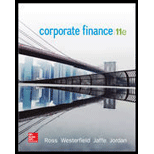
Concept explainers
a.
To determine: To Construct a Portfolio Containing Securities 1 and 2, the Expected Return and
Introduction:
Arbitrage Pricing Theory (APT) is a substitute form of CAPM (
b.
To determine: To Construct a Portfolio Containing Securities 3 and 4, the Expected Return and
c.
To determine: The Possible Arbitrage Opportunity.
d.
To determine: The Effects of Existence of such Arbitrage Opportunities’ and Graphing the Findings.
Want to see the full answer?
Check out a sample textbook solution
Chapter 12 Solutions
Corporate Finance (The Mcgraw-hill/Irwin Series in Finance, Insurance, and Real Estate)
- image is blurr please comment i will write values then solve.Please don't solve i mistakely posted blurr image. i will give unhelpful if answer is incorrect..arrow_forwardYou are thinking of inving in Tikki's Torches, Inc. You have only the following information on the at year-end 2008: Net income0.000 Total debt 12.2 million Debt ratio 42% What is Tikki's ROE for 2008? a. 1.79% b. 10.14% c. 3.09% d. 4.26%arrow_forwardPlease don't sopve i mistakely posted blurr image. i will give unhelpful if answer is incorrect..arrow_forward
- Iarrow_forwardno solve with assumption data Please don't solve i mistakely posted blurr image. i will give unhelpful if answer is incorrect..arrow_forwardCrenshaw, Incorporated, is considering the purchase of a $367,000 computer with an economic life of five years. The computer will be fully depreciated over five years using the straight-line method. The market value of the computer will be $67,000 in five years. The computer will replace five office employees whose combined annual salaries are $112,000. The machine will also immediately lower the firm's required net working capital by $87,000. This amount of net working capital will need to be replaced once the machine is sold. The corporate tax rate is 22 percent. The appropriate discount rate is 15 percent. Calculate the NPV of this project. Note: Do not round intermediate calculations and round your answer to 2 decimal places, e.g., 32.16. NPV Answer is complete but not entirely correct. S 103,141.80arrow_forward
- Your firm is contemplating the purchase of a new $610,000 computer-based order entry system. The system will be depreciated straight-line to zero over its five-year life. It will be worth $66,000 at the end of that time. You will save $240,000 before taxes per year in order processing costs, and you will be able to reduce working capital by $81,000 (this is a one-time reduction). If the tax rate is 21 percent, what is the IRR for this project? Note: Do not round intermediate calculations and enter your answer as a percent rounded to 2 decimal places, e.g., 32.16. IRR %arrow_forwardQUESTION 1 Examine the information provided below and answer the following question. (10 MARKS) The hockey stick model of start-up financing, illustrated by the diagram below, has received a lot of attention in the entrepreneurial finance literature (Cumming & Johan, 2013; Kaplan & Strömberg, 2014; Gompers & Lerner, 2020). The model is often used to describe the typical funding and growth trajectory of many startups. The model emphasizes three main stages, each of which reflects a different phase of growth, risk, and funding expectations. Entrepreneur, 3 F's Debt(banks & microfinance) Research Business angels/Angel Venture funds/Venture capitalists Merger, Acquisition Grants investors PO Public market Growth (revenue) Break even point Pide 1st round Expansion 2nd round 3rd round Research commercial idea Pre-seed Initial concept Seed Early Expansion Financial stage Late IPO Inception and prototype Figure 1. The hockey stick model of start-up financing (Lasrado & Lugmayr, 2013) REQUIRED:…arrow_forwardcritically discuss the hockey stick model of a start-up financing. In your response, explain the model and discibe its three main stages, highlighting the key characteristics of each stage in terms of growth, risk, and funding expectations.arrow_forward

 Intermediate Financial Management (MindTap Course...FinanceISBN:9781337395083Author:Eugene F. Brigham, Phillip R. DavesPublisher:Cengage Learning
Intermediate Financial Management (MindTap Course...FinanceISBN:9781337395083Author:Eugene F. Brigham, Phillip R. DavesPublisher:Cengage Learning

